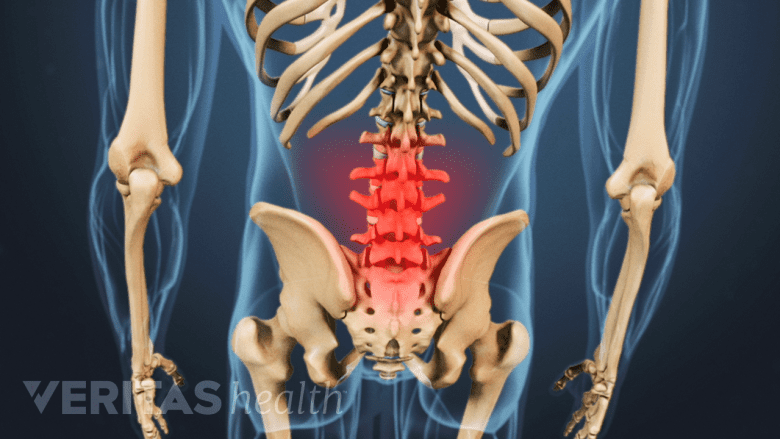While acetaminophen is widely used and has benefits compared to other pain medications, there are possible drawbacks that should be considered, including some that can be serious.
In This Article:
- Acetaminophen for Back Pain
- Acetaminophen Potential Risks and Complications
- Medications for Back Pain Video
FDA Sets Limit on Dosage
The FDA advises that the maximum safe daily dose for acetaminophen is 3000 mg for adults which equates to taking no more than six extra-strength (500mg) acetaminophen in a day. Health advocates recommend this limit of 3000 mg, since some people’s bodies are especially sensitive to acetaminophen’s effects.1Acetaminophen safety: Be cautious but not afraid. Harvard Health Publications, Harvard Medical School. 9 October 2015. Available at http://www.health.harvard.edu/pain/acetaminophen-safety-be-cautious-but-not-afraid
Risk of Acetaminophen Overdose
The risk of overdose—which can lead to acute liver failure—is the most significant risk associated with acetaminophen. People may not be aware that acetaminophen is used in combination with other drugs in many over-the-counter and opioid medications, which makes it easier to take more than the recommended dose. Acetaminophen is a common ingredient in over-the-counter cough and cold medication, such as Alka-Seltzer Plus and Sudafed, as well as in prescription opioids, such as Norco.
An overdose of acetaminophen, whether intentional or accidental, is serious, causing liver damage, and can be fatal. Anyone who shows signs of an overdose needs immediate medical attention. Signs of an acetaminophen overdose include:
- Nausea and vomiting
- Abdominal pain, particularly on the right side
- Loss of appetite
Because acetaminophen is metabolized in the liver, people with liver infections, certain illnesses, or chronic alcohol use may be more susceptible to overdose. A medication called N-acetylcysteine (NAC) can be used treat an overdose but is most successful if administered within eight hours of the overdose to help remove the acetaminophen from the body.2Smilkstein MJ, Knapp GL, Kulig KW, Rumack BH. Efficacy of oral Nacetylcysteine in the treatment of acetaminophen overdose. Analysis of the national multicenter study (1976 to 1985) N Engl J Med. 1988 Dec 15;319(24):1557-62.
How to Avoid Acetaminophen Overuse or Overdose
To minimize the potential risk of overuse or overdose, patients need to:
- Carefully track the amount taken in any 24-hour period
- Review the ingredient list on medication—prescription or over-the-counter—to check for any other sources of acetaminophen to avoid inadvertently taking too much
- Check the label for alternative terms used for acetaminophen; it is sometimes called “APAP” on prescription pill bottles or other forms of medication
- Anyone who has or suspects they may have liver disease or infection, or who drinks 3 or more alcoholic drinks a day, should consult with the prescribing physician and/or pharmacist before taking acetaminophen in any form.
While relatively rare, there are a number of potential risks and complications associated with acetaminophen. It is advisable to consult with a physician or pharmacist regarding any concerns or unusual side effects.
Effectiveness Questioned

Acetaminophen is less effective for low back pain and osteoarthritis.
While acetaminophen has been shown to be effective in other cases, such as with headaches or fever, research has questioned acetaminophen’s effectiveness in controlling pain and speeding recovery in cases of acute back pain.
One analysis of multiple clinical studies found acetaminophen ineffective in easing low back pain, and of minimal help against osteoarthritis, the most common form of arthritis, and one that is often connected to back pain.3Saragiotto BT, Machado GC, Ferreira ML, Pinheiro MB, Abdel Shaheed C, Maher CG. Paracetamol for low back pain. Cochrane Database Syst Rev. 2016 Jun 7;(6):CD012230. doi: 10.1002/14651858.CD012230. Review. PubMed PMID: 27271789; PubMed Central PMCID: PMC6353046. Another study concluded that acetaminophen worked no better than a placebo in shortening patients’ recovery time for acute back pain.4Williams, CM, et al. Efficacy of paracetamol for acute low-back pain: a double-blind, randomised controlled trial. The Lancet, Vol. 384, No. 9954, p1586–1596, 1 November 2014.
Physicians’ reactions to the research finding have been mixed. While some supported the findings, others found fault with the studies and suggested more research is needed before concluding that acetaminophen is not helpful.
Individuals respond differently to pain relievers, making it likely that acetaminophen may be a good choice for a number of people. People should discuss with a physician to find the best form of pain relief for his or her situation.
- 1 Acetaminophen safety: Be cautious but not afraid. Harvard Health Publications, Harvard Medical School. 9 October 2015. Available at http://www.health.harvard.edu/pain/acetaminophen-safety-be-cautious-but-not-afraid
- 2 Smilkstein MJ, Knapp GL, Kulig KW, Rumack BH. Efficacy of oral Nacetylcysteine in the treatment of acetaminophen overdose. Analysis of the national multicenter study (1976 to 1985) N Engl J Med. 1988 Dec 15;319(24):1557-62.
- 3 Saragiotto BT, Machado GC, Ferreira ML, Pinheiro MB, Abdel Shaheed C, Maher CG. Paracetamol for low back pain. Cochrane Database Syst Rev. 2016 Jun 7;(6):CD012230. doi: 10.1002/14651858.CD012230. Review. PubMed PMID: 27271789; PubMed Central PMCID: PMC6353046.
- 4 Williams, CM, et al. Efficacy of paracetamol for acute low-back pain: a double-blind, randomised controlled trial. The Lancet, Vol. 384, No. 9954, p1586–1596, 1 November 2014.

